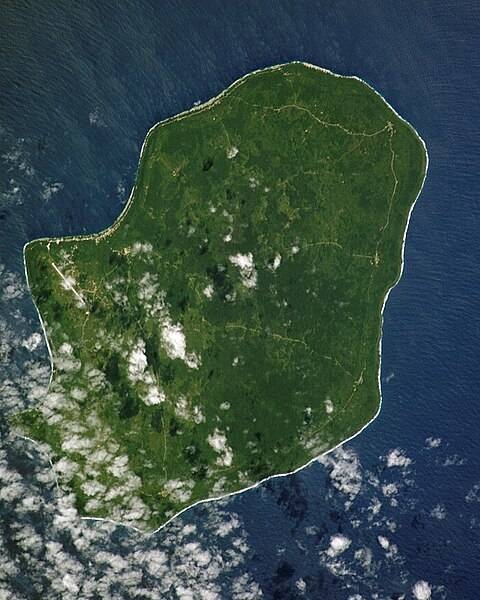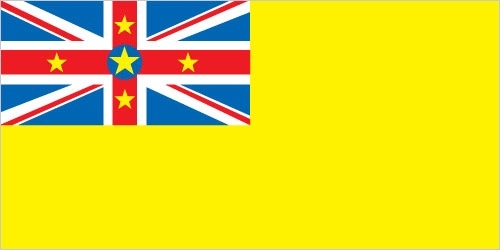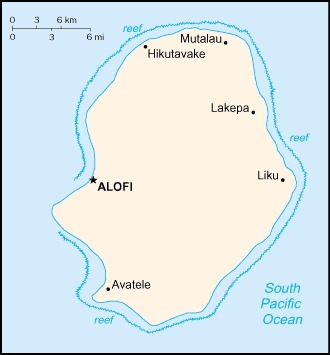Introduction
Background
Voyagers from Samoa first settled on Niue around A.D. 900 and a second main group of settlers came from Tonga around 1500. With only one reliable source of fresh water, conflict was high on the island. There was continued contact with both Samoa and Tonga, and customs from those islands heavily influenced Niuean culture, including the formation of an island-wide kingship system in the early 1700s. These kings, or patu-iki, were elected by Niueans. In 1774, British explorer James COOK abandoned attempts to land on the island after several unsuccessful tries, and he named it Savage Island because of the warlike appearance of the Niueans. Missionaries arrived in 1830 but were also largely unsuccessful at staying on the island until 1846, when a Niuean trained as a Samoan missionary returned to the island and provided a space from which the missionaries could work. In addition to converting the population, the missionaries worked to stop the violent conflicts between Niueans and helped establish the first parliament in 1849.
In 1889, King FATAAIKI and other chiefs asked the UK for protectorate status, a request that was repeated in 1895. The UK finally agreed in 1900 and King TOGIA-PULU-TOAKI formally ceded Niue that year. In 1901, Niue was annexed to New Zealand and included as part of the Cook Islands. Niue’s remoteness and cultural and linguistic differences with the Cook Islands led New Zealand to separate Niue into its own administration in 1904. The island became internally self-governing in 1974; it is an independent member of international organizations, but is in free association with New Zealand, which is responsible for defense and foreign affairs.
Economic opportunities in Niue are sparse. The population has trended downwards over recent decades, with substantial emigration to New Zealand. In 2004, a cyclone destroyed much of the southern part of the capital, Alofi, and left about 15% of the population homeless. Many chose not to rebuild and instead moved to New Zealand (2,400 km to the southwest), where approximately 90% of all ethnic Niueans live.
Visit the Definitions and Notes page to view a description of each topic.
Geography
Location
Oceania, island in the South Pacific Ocean, east of Tonga
Geographic coordinates
19 02 S, 169 52 W
Map references
Oceania
Area - comparative
1.5 times the size of Washington, DC
Land boundaries
total: 0 km
Coastline
64 km
Maritime claims
territorial sea: 12 nm
exclusive economic zone: 200 nm
Climate
tropical; modified by southeast trade winds
Terrain
steep limestone cliffs along coast, central plateau
Elevation
highest point: unnamed elevation 1.4 km east of Hikutavake 80 m
lowest point: Pacific Ocean 0 m
Natural resources
arable land, fish
Land use
agricultural land: 19.1% (2018 est.)
arable land: 3.8% (2018 est.)
permanent crops: 11.5% (2018 est.)
permanent pasture: 3.8% (2018 est.)
forest: 71.2% (2018 est.)
other: 9.7% (2018 est.)
Irrigated land
0 sq km (2012)
Population distribution
population distributed around the peripheral coastal areas of the island
Natural hazards
tropical cyclones
Geography - note
one of world's largest coral islands; the only major break in the surrounding coral reef occurs in the central western part of the coast
People and Society
Population
2,000 (July 2021 est.)
note: because of the island's limited economic and educational opportunities, Niueans have emigrated for decades - primarily to New Zealand, but also to Australia and other Pacific island states; Niue's population peaked in 1966 at 5,194, but by 2005 had fallen to 1,508; since then it has rebounded slightly; as of 2013, 23,883 people of Niuean ancestry lived in New Zealand - with more than 20% Niue-born; this means that there are about 15 times as many persons of Niuean ancestry living in New Zealand as in Niue, possibly the most eccentric population distribution in the world
Nationality
noun: Niuean(s)
adjective: Niuean
Ethnic groups
Niuean 65.4%, part-Niuean 14%, non-Niuean 20.6% (2017 est.)
note: data represent the resident population
Languages
Niuean (official) 46% (a Polynesian language closely related to Tongan and Samoan), Niuean and English 32%, English (official) 11%, Niuean and others 5%, other 6% (2011 est.)
Religions
Ekalesia Niue (Congregational Christian Church of Niue - a Protestant church founded by missionaries from the London Missionary Society) 61.7%, Church of Jesus Christ 8.7%, Roman Catholic 8.4%, Jehovah's Witness 2.7%, Seventh Day Adventist 1.4%, other 8.2%, none 8.9% (2017 est.)
Age structure
0-14 years: NA
15-24 years: NA
25-54 years: NA
55-64 years: NA
65 years and over: NA
Dependency ratios
total dependency ratio: NA
youth dependency ratio: NA
elderly dependency ratio: NA
potential support ratio: NA
Death rate
NA (2021 est.)
Population distribution
population distributed around the peripheral coastal areas of the island
Urbanization
urban population: 46.9% of total population (2021)
rate of urbanization: 1.43% annual rate of change (2020-25 est.)
Major urban areas - population
1,000 ALOFI (capital) (2018)
Infant mortality rate
total: NA
male: NA
female: NA (2021 est.)
Life expectancy at birth
total population: NA
male: NA
female: NA (2021 est.)
Total fertility rate
NA (2021 est.)
Drinking water source
improved: total: 98.2% of population
unimproved: total: 1.8% of population (2017 est.)
Current Health Expenditure
8.3% (2018)
Sanitation facility access
improved: total: 96.8% of population
unimproved: total: 3.2% of population (2017 est.)
Major infectious diseases
degree of risk: high (2020)
food or waterborne diseases: bacterial diarrhea
vectorborne diseases: malaria
Environment
Environment - current issues
increasing attention to conservationist practices to counter loss of soil fertility from traditional slash and burn agriculture
Environment - international agreements
party to: Biodiversity, Climate Change, Climate Change-Kyoto Protocol, Climate Change-Paris Agreement, Comprehensive Nuclear Test Ban, Desertification, Law of the Sea, Ozone Layer Protection, Ship Pollution
signed, but not ratified: none of the selected agreements
Air pollutants
particulate matter emissions: 11.47 micrograms per cubic meter (2016 est.)
Climate
tropical; modified by southeast trade winds
Land use
agricultural land: 19.1% (2018 est.)
arable land: 3.8% (2018 est.)
permanent crops: 11.5% (2018 est.)
permanent pasture: 3.8% (2018 est.)
forest: 71.2% (2018 est.)
other: 9.7% (2018 est.)
Urbanization
urban population: 46.9% of total population (2021)
rate of urbanization: 1.43% annual rate of change (2020-25 est.)
Major infectious diseases
degree of risk: high (2020)
food or waterborne diseases: bacterial diarrhea
vectorborne diseases: malaria
Total renewable water resources
0 cubic meters (2017 est.)
Government
Country name
conventional long form: none
conventional short form: Niue
former: Savage Island
etymology: the origin of the name is obscure; in Niuean, the word supposedly translates as "behold the coconut"
note: pronunciation falls between nyu-way and new-way, but not like new-wee
Government type
parliamentary democracy
Dependency status
self-governing in free association with New Zealand since 1974; Niue is fully responsible for internal affairs; New Zealand retains responsibility for external affairs and defense; however, these responsibilities confer no rights of control and are only exercised at the request of the Government of Niue
Capital
name: Alofi
geographic coordinates: 19 01 S, 169 55 W
time difference: UTC-11 (6 hours behind Washington, DC, during Standard Time)
Administrative divisions
none; note - there are no first-order administrative divisions as defined by the US Government, but there are 14 villages at the second order
Independence
19 October 1974 (Niue became a self-governing state in free association with New Zealand)
National holiday
Waitangi Day (Treaty of Waitangi established British sovereignty over New Zealand), 6 February (1840)
Constitution
history: several previous (New Zealand colonial statutes); latest 19 October 1974 (Niue Constitution Act 1974)
amendments: proposed by the Assembly; passage requires at least two-thirds majority vote of the Assembly membership in each of three readings and approval by at least two-thirds majority votes in a referendum; passage of amendments to a number of sections, including Niue’s self-governing status, British nationality and New Zealand citizenship, external affairs and defense, economic and administrative assistance by New Zealand, and amendment procedures, requires at least two-thirds majority vote by the Assembly and at least two thirds of votes in a referendum; amended 1992, 2007; note - in early 2021, the constitution review committee of the Assembly requested suggestions from the public about changes to the constitution
Legal system
English common law
Suffrage
18 years of age; universal
Executive branch
chief of state: Queen ELIZABETH II (since 6 February 1952); represented by Governor-General of New Zealand Dame Patricia Lee REDDY (since 28 September 2016); the UK and New Zealand are represented by New Zealand High Commissioner Kirk YATES (since May 2018)
head of government: Premier Dalton TAGELAGI (since 10 June 2020)
cabinet: Cabinet chosen by the premier
elections/appointments: the monarchy is hereditary; premier indirectly elected by the Legislative Assembly for a 3-year term; election last held on 10 June 2020 (next to be held in 2023)
election results: Dalton TAGELAGI elected premier; Legislative Assembly vote - Dalton TAGELAGI (independent) 13, O'Love JACOBSEN (independent) 7; Toke TALAGI lost his seat in election
Legislative branch
description: unicameral Assembly or Fono Ekepule (20 seats; 14 members directly elected in single-seat constituencies by simple majority vote and 6 directly elected from the National Register or "common roll" by majority vote; members serve 3-year terms)
elections: last held on 30 May 2020 (next to be held on 2023)
election results: percent of vote by party - NA; seats by party - independent 20
Judicial branch
highest courts: Court of Appeal (consists of the chief justice and up to 3 judges); note - the Judicial Committee of the Privy Council (in London) is the final appeal court beyond the Niue Court of Appeal
judge selection and term of office: Niue chief justice appointed by the governor general on the advice of the Cabinet and tendered by the premier; other judges appointed by the governor general on the advice of the Cabinet and tendered by the chief justice and the minister of justice; judges serve until age 68
subordinate courts: High Court
note: Niue is a participant in the Pacific Judicial Development Program, which is designed to build governance and the rule of law in 15 Pacific island countries
Political parties and leaders
Alliance of Independents or AI
Niue People's Action Party or NPP [Young VIVIAN]
International organization participation
ACP, AOSIS, FAO, IFAD, OPCW, PIF, Sparteca, SPC, UNESCO, UPU, WHO, WIPO, WMO
Diplomatic representation in the US
none (self-governing territory in free association with New Zealand)
Diplomatic representation from the US
embassy: none (self-governing territory in free association with New Zealand)
Flag description
yellow with the flag of the UK in the upper hoist-side quadrant; the flag of the UK bears five yellow five-pointed stars - a large star on a blue disk in the center and a smaller star on each arm of the bold red cross; the larger star stands for Niue, the smaller stars recall the Southern Cross constellation on the New Zealand flag and symbolize links with that country; yellow represents the bright sunshine of Niue and the warmth and friendship between Niue and New Zealand
National symbol(s)
yellow, five-pointed star; national color: yellow
National anthem
name: "Ko e Iki he Lagi" (The Lord in Heaven)
lyrics/music: unknown/unknown, prepared by Sioeli FUSIKATA
note: adopted 1974
Economy
Economic overview
The economy suffers from the typical Pacific island problems of geographic isolation, few resources, and a small population. The agricultural sector consists mainly of subsistence gardening, although some cash crops are grown for export. Industry consists primarily of small factories for processing passion fruit, lime oil, honey, and coconut cream. The sale of postage stamps to foreign collectors is an important source of revenue.
Government expenditures regularly exceed revenues, and the shortfall is made up by critically needed grants from New Zealand that are used to pay wages to public employees. Economic aid allocation from New Zealand in FY13/14 was US$10.1 million. Niue has cut government expenditures by reducing the public service by almost half.
The island in recent years has suffered a serious loss of population because of emigration to New Zealand. Efforts to increase GDP include the promotion of tourism and financial services, although the International Banking Repeal Act of 2002 resulted in the termination of all offshore banking licenses.
GDP (official exchange rate)
$10.01 million (2003) (2003)
GDP - composition, by sector of origin
agriculture: 23.5% (2003)
industry: 26.9% (2003)
services: 49.5% (2003)
Agricultural products
coconuts, taro, fruit, sweet potatoes, tropical fruit, yams, vegetables, lemons, limes, bananas
Industries
handicrafts, food processing
Labor force - by occupation
note: most work on family plantations; paid work exists only in government service, small industry, and the Niue Development Board
Household income or consumption by percentage share
lowest 10%: NA
highest 10%: NA
Budget
revenues: 15.07 million (FY04/05)
expenditures: 16.33 million (FY04/05)
Fiscal year
1 April - 31 March
Exports - partners
Indonesia 92%, South Korea 5% (2019)
Exports - commodities
tanker ships, fruit juice, thermostats, textiles, measurement devices/appliances (2019)
Imports - partners
New Zealand 43%, United Kingdom 30%, Japan 22% (2019)
Imports - commodities
hydraulic engines, ships, refined petroleum, cars, plastics (2019)
Exchange rates
New Zealand dollars (NZD) per US dollar -
1.416 (2017 est.)
1.4279 (2016 est.)
1.4279 (2015)
1.4279 (2014 est.)
1.2039 (2013 est.)
Energy
Electricity - from fossil fuels
87% of total installed capacity (2016 est.)
country comparison to the world: 65Electricity - from nuclear fuels
0% of total installed capacity (2017 est.)
country comparison to the world: 158Electricity - from hydroelectric plants
0% of total installed capacity (2017 est.)
country comparison to the world: 191Electricity - from other renewable sources
13% of total installed capacity (2017 est.)
country comparison to the world: 67Communications
Telecommunication systems
general assessment: sole provider service for over 1000 landlines and fixed wireless lines; cellular telephone service operates on AMPS and GSM platforms; difficult geography presents challenges for rural areas; mobile is primary source of Internet access; mobile broadband demand is growing due to mobile services (2020)
domestic: single-line (fixed line) telephone system connects all villages (and virtually all households) on island (2018)
international: country code - 683; landing point for the Manatua submarine cable linking Niue to several South Pacific Ocean Islands; expansion of satellite services (2019)
note: the COVID-19 pandemic continues to have a significant impact on production and supply chains globally; since 2020, some aspects of the telecom sector have experienced downturn, particularly in mobile device production; many network operators delayed upgrades to infrastructure; progress towards 5G implementation was postponed or slowed in some countries; consumer spending on telecom services and devices was affected by large-scale job losses and the consequent restriction on disposable incomes; the crucial nature of telecom services as a tool for work and school from home became evident, and received some support from governments
Broadcast media
1 government-owned TV station with many of the programs supplied by Television New Zealand; 1 government-owned radio station broadcasting in AM and FM (2019)
Internet users
total: 1,286 (2021 est.)
percent of population: 79.56% (2019 est.)
Telephones - fixed lines
total subscriptions: 1,000 (2018)
subscriptions per 100 inhabitants: 61.77 (2018)
Transportation
Airports - with paved runways
total: 1
1,524 to 2,437 m: 1 (2021)
Merchant marine
total: 69
by type: bulk carrier 3, container ship 2, general cargo 25, oil tanker 7, other 32 (2021)
Ports and terminals
major seaport(s): Alofi
Military and Security
Military and security forces
no regular indigenous military forces; Police Force
Military - note
defense is the responsibility of New Zealand



